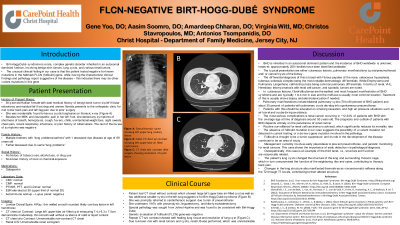Back

Clinical: General Topics
FLCN-Negative Birt-Hogg-Dubé syndrome
Friday, March 31, 2023
12:00 PM East Coast USA Time

- AS
Aasim Soomro, DO (he/him/his)
PGY-3
CarePoint Health - Christ Hospital
Jersey City, New Jersey, United States
Second Author(s)
Introduction: Birt-Hogg-Dubé syndrome is a rare, complex genetic disorder inherited in an autosomal dominant fashion, involving benign skin tumors, lung cysts, and various renal tumors. The unusual clinical finding in our case is that the patient tested negative for known mutations in the hallmark FLCN (folliculin) gene, while having the characteristic clinical findings and pathology report suggestive of the disease – this indicates there may be other variant mutations in this gene.
Case Study: We present a rare case of a 50-year-old Haitian female with past medical history of benign bone tumor and family history of father and brother deceased due to lung disease of unclear etiology, who initially presented to the clinic for evaluation of back pain. Incidentally, the thoracic X-ray showed a cavitary lesion in the left hemithorax. CT chest showed a large left upper lobe air-filled cyst as well as two additional smaller cysts in the left lung suggestive for Birt-Hogg-Dubé syndrome and was promptly referred to cardiothoracic surgeon given the risk for spontaneous pneumothorax. However, malignancy, pleuropulmonary blastoma, bronchogenic cyst, lymphangioleiomyomatosis, and post-traumatic causes were in the differential. To obtain the diagnosis, she underwent VATS, pneumolysis with excision of lesion. However, the genetic test of the folliculin gene was negative for established mutations. Repeat CT chest showed resolution of the cyst. Special pathology evaluation was sought from John's Hopkins and they found the lesion was consistent with Birt-Hogg-Dubé.
Discussion: Osteopathically, this case is an example of the third tenet, i.e., structure and function are reciprocally related. The patient’s lung cysts changed the structure of the lung and surrounding thoracic cage, which in turn compromised the function of the neighboring ribs and spine, contributing in the patient’s thoracic back pain. Changes in the lung structure also manifested themselves as viscerosomatic reflexes along the T2 through T7 levels, contributing to their altered structure.
The absence of folliculin mutation in our case suggests the possibility of a variant mutation not detected in current testing, or a de-novo gene mutation involved in the pathology. Folliculin is thought to be a tumor suppressor, and its role in the development of the disease continues to be an area of study. Management currently involves early pleurodesis to prevent pneumothorax, and periodic monitoring for renal cancers. This case shows the importance of early detection via pathological diagnosis.
Case Study: We present a rare case of a 50-year-old Haitian female with past medical history of benign bone tumor and family history of father and brother deceased due to lung disease of unclear etiology, who initially presented to the clinic for evaluation of back pain. Incidentally, the thoracic X-ray showed a cavitary lesion in the left hemithorax. CT chest showed a large left upper lobe air-filled cyst as well as two additional smaller cysts in the left lung suggestive for Birt-Hogg-Dubé syndrome and was promptly referred to cardiothoracic surgeon given the risk for spontaneous pneumothorax. However, malignancy, pleuropulmonary blastoma, bronchogenic cyst, lymphangioleiomyomatosis, and post-traumatic causes were in the differential. To obtain the diagnosis, she underwent VATS, pneumolysis with excision of lesion. However, the genetic test of the folliculin gene was negative for established mutations. Repeat CT chest showed resolution of the cyst. Special pathology evaluation was sought from John's Hopkins and they found the lesion was consistent with Birt-Hogg-Dubé.
Discussion: Osteopathically, this case is an example of the third tenet, i.e., structure and function are reciprocally related. The patient’s lung cysts changed the structure of the lung and surrounding thoracic cage, which in turn compromised the function of the neighboring ribs and spine, contributing in the patient’s thoracic back pain. Changes in the lung structure also manifested themselves as viscerosomatic reflexes along the T2 through T7 levels, contributing to their altered structure.
The absence of folliculin mutation in our case suggests the possibility of a variant mutation not detected in current testing, or a de-novo gene mutation involved in the pathology. Folliculin is thought to be a tumor suppressor, and its role in the development of the disease continues to be an area of study. Management currently involves early pleurodesis to prevent pneumothorax, and periodic monitoring for renal cancers. This case shows the importance of early detection via pathological diagnosis.
